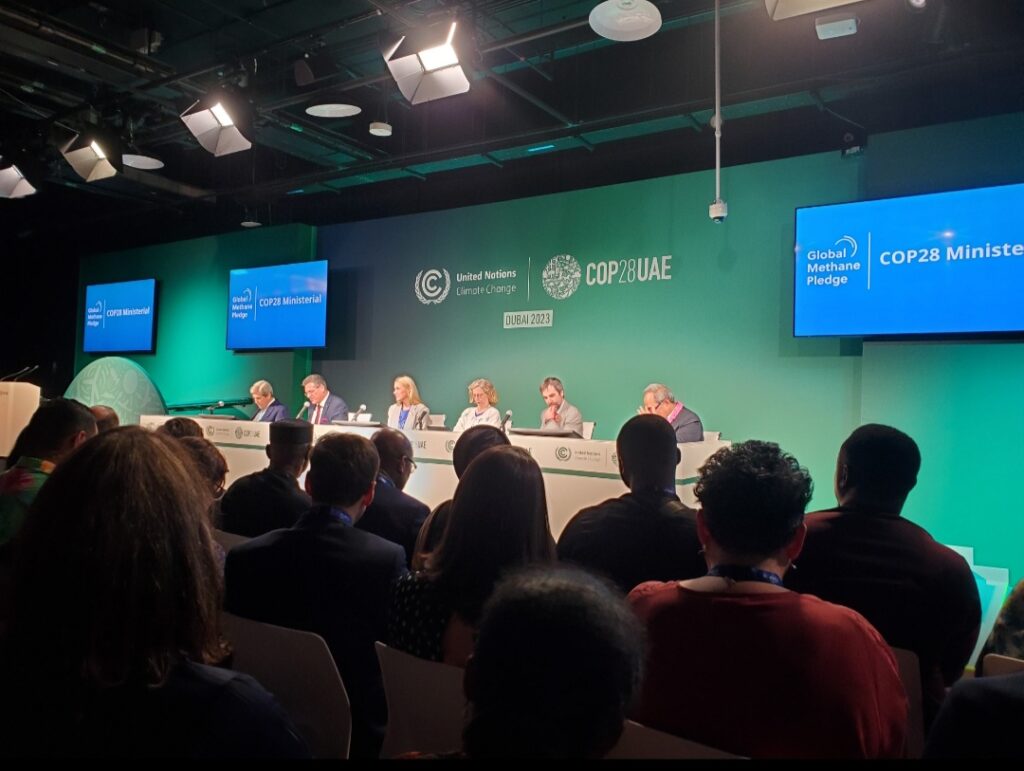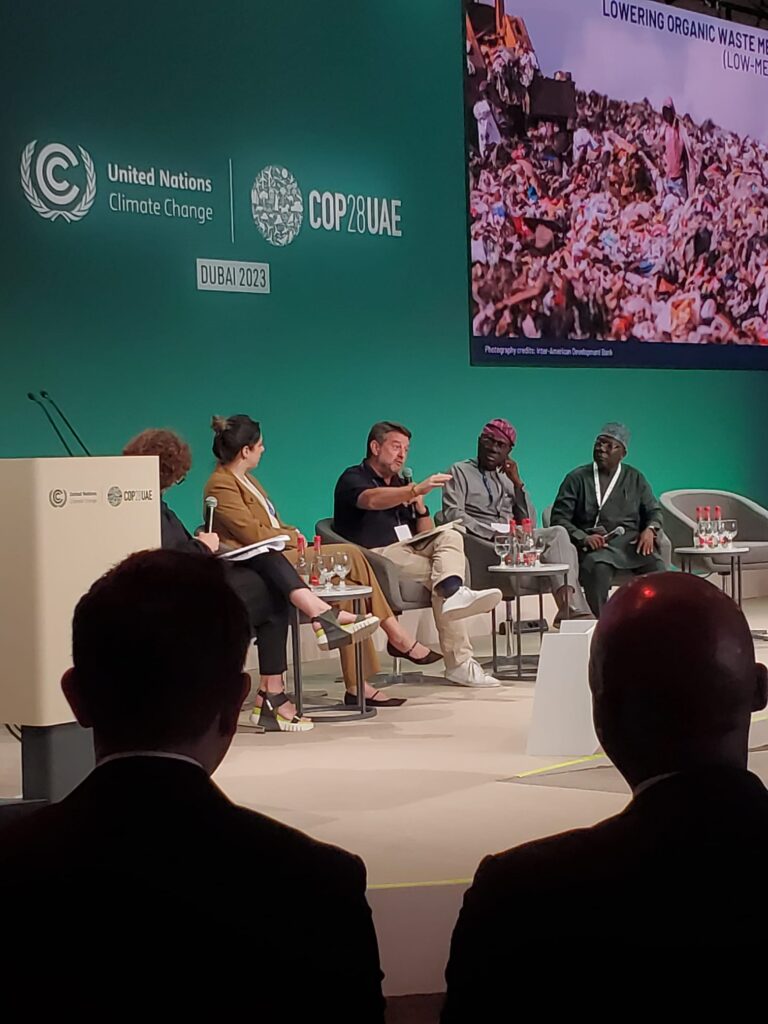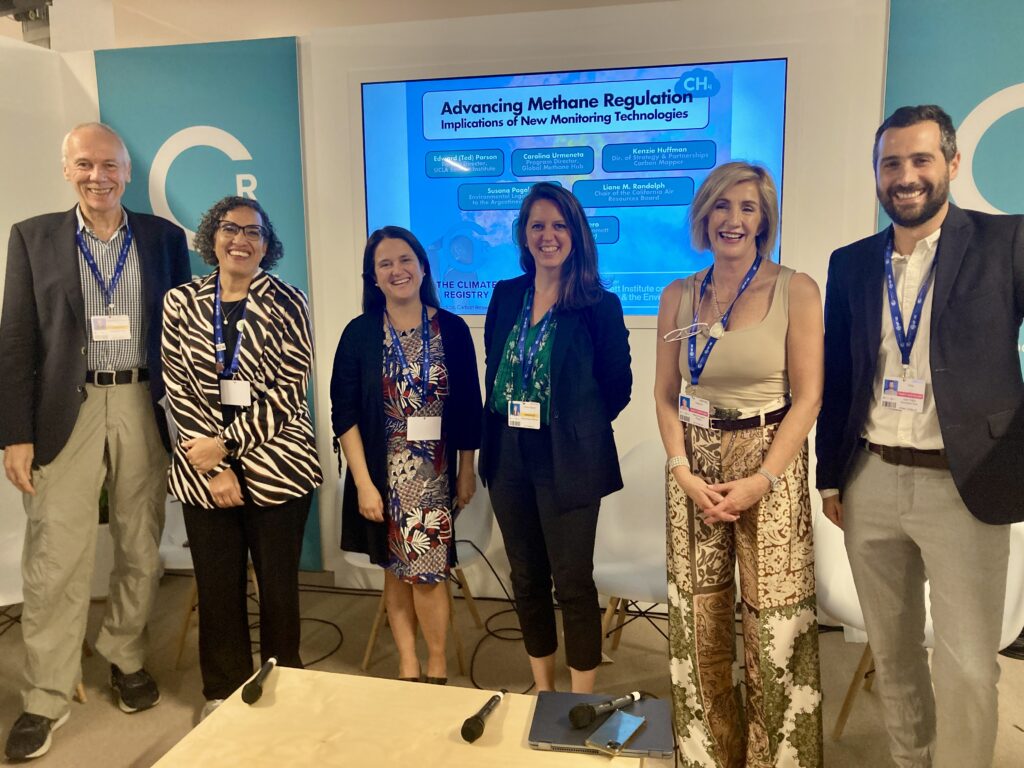COP28: “The Methane COP”
Methane was at the center of COP28. Here are some of the most relevant announcements of this year’s Conference of the Parties.
By far, the most ubiquitous figure at COP28 was that of John Kerry. The U.S. climate envoy strolled through the labyrinthine and confusing alleys of Dubai’s Expo City wearing an impeccable suit despite the almost 100-degree Fahrenheit winter weather of the United Arab Emirates. When he wasn’t walking, he was talking about methane, earning him the nickname Mr. Methane.
Until recently, few could have anticipated that methane, a GHG not even mentioned in the Paris Agreement, would be central to COP28’s most headline-grabbing announcements. This shift is good news because tackling methane is crucial to the fight against climate change due to its significantly higher global warming potential than CO2, the disposal of relatively cheap methods of controlling emissions, and its short atmospheric lifespan.
I attended the conference as part of the UCLA Emmett Institute’s delegation, which hosted a side event on the implications of new monitoring technologies for methane. At COP28, I witnessed firsthand how relevant methane is for climate discussions, how jurisdictions are focusing their attention on this GHG, and how crucial technology may be for tackling methane emissions.
In this post, I will run you through some of the most relevant methane-related announcements I saw at Dubai’s 28th Conference of the Parties.
Summit on Methane and Non-C02 GHGs

In a high-profile event at the main stage of COP28, the U.S., China, and United Arab Emirates hosted the Summit on Methane and non-CO2 Greenhouse Gases that called on the parties of the Paris Agreement to include methane and other GHGs in their nationally determined contributions (NDC). This statement is relevant since the parties did not always inform methane emissions; therefore, they were usually ignored in the actions that followed Nationally Determined Contributions, or NDCs.
Another significant announcement from the Summit was the incorporation of Turkmenistan – one of the world’s top emitters-Kazakhstan, Angola, Kenya, and Romania to the Global Methane Pledge, a commitment to reduce methane emissions by 30% from 202 levels by 2030. With these incorporations, 156 countries have joined the pledge, notably not China.
In addition, Kazakhstan and the U.S. announced a cooperation partnership to help the Central Asian country meet the Global Methane Pledge’s goals by developing national standards to eliminate non-emergency venting of methane, among other actions.
Financing reduction of methane emissions
Methane emissions are over 80 times more potent than CO2 in the first two decades and are responsible for approximately 30% of global warming. However, methane reduction efforts have not received the same financial support as CO2 actions; in 2019 and 2020, only 2% of climate finance was devoted to methane mitigation.
To address this financial deficit, governments, the private sector, and philanthropies announced the creation of a $1 billion fund to finance methane reduction initiatives in all sectors. The fund will be administered by various entities, such as the Global Methane Hub and the World Bank, focusing the efforts on low-income countries.
California subnational action
The term “Subnational” was among the most popular concepts at COP28. Subnational actions were in the spotlight because it is clear that the real work is done on the ground, where local policy decisions are made, and not in the hallways of big international conventions.
Leading this subnational trend, California officials launched the Subnational Methane Action Coalition, an international partnership between subnational governments that have some responsibility in overseeing or regulating sources of methane emissions. Subnational governments of Brazil, Bolivia, South Korea, Germany, Spain, Canada, Nigeria, and the United States are among the signatories of the coalition.
The goal of the coalition is to enable a space of collaboration to implement actionable and effective solutions for methane emissions abatement.
Jurisdictions announced new methane regulations
COPs are usually the place where governments announce their recent environmental laws and regulations. This year, several jurisdictions announced new methane regulations.
Possibly the most publicized announcement was the adoption of the long-expected EPA’s Final Rule for Oil and Natural Gas Operations, which aims to decrease methane emissions from oil and gas activities significantly. This initiative is expected to result in a reduction of over 1.5 gigatons of CO2 equivalent and achieve an almost 80% decrease compared to projected future methane emissions without these rules.
Across the pond, the European Union announced the enactment of its own methane regulations, establishing ambitious criteria for monitoring and reducing methane from domestically produced and imported fossil oil, gas, and coal. The regulations include the implementation of a methane import standard by the year 2030.
Since the E.U. is one of the world’s largest oil and gas importers, foreign producers will be forced to meet E.U. standards if they want to continue selling their products in the European Zone. Sometimes, when international commitments fail, manipulating the market could be an effective driver for change. If these regulations are successful, jurisdictions could replicate this model for methane or other GHGs.
Canada also announced regulations to achieve a substantial reduction in methane emissions within the upstream oil and gas sector, targeting at least a 75% decrease below 2012 levels by the year 2030.
Brazil has declared that its National Council of Energy Policy will formulate guidelines for methane reduction in the oil and gas sector by the end of 2024.
Egypt has expressed its intent to create domestic methane regulations within its oil and gas sector by the conclusion of 2024.
Nigeria announced projects estimated to capture more than half of all gas flaring volumes in the country under the Nigeria Gas Flare Commercialization Program (NGFCP).
Oil and Gas Decarbonization Charter
Fossil fuels are the main reason for CO2 emissions and, therefore, the main driver of climate change. Many of us hoped that this COP would be the moment to agree on a path to phasing out fossil fuels. However, COP28’s outcomes were timid and far from satisfactory, which was not a real surprise, given the recalcitrance of many nations and the host country’s being a major oil producer.
However, oil companies did agree to much more aggressive methane reduction commitments. One bright example is the creation of the Oil and Gas Decarbonization Charter, an initiative from 50 oil and gas companies to “speed up climate action within the industry,” that was announced by COP28’s President, Dr. Sultan Al Jaber –also the CEO of the Abu Dhabi National Oil Company.
The goal of the Charter is to align the industry around the commitment to net-zero emission by 2050, near zero upstream methane emissions, and ending routine flaring by 2030.
There is no doubt that is good news. However, it is also a low-hanging fruit. Abating methane emissions from the oil and gas sector could be successfully achieved at a comparatively low cost. In addition, methane is not only a pollutant but also a valuable resource that companies sell as natural gas. Therefore, companies are willing to invest in avoiding methane leaks because it does not hurt their bottom line like reducing CO2 emissions does.
Promising announcements from the waste sector
For the first time, this year’s COP was the opportunity for countries, jurisdictions, financial institutions, and NGOs to announce various initiatives to address methane emissions from the waste sector.

Notably, the conference was the stage for the launch of the Lowering Organic Waste Methane (LOW-Methane). This initiative aims to substantially increase worldwide efforts to reduce methane emissions from the waste sector. LOW-Methane’s goal is to reach a minimum of 1 million metric tons in annual methane reductions from the waste sector well in advance of 2030, involving 40 subnational jurisdictions, and to facilitate investment of over $10 billion.
Another relevant initiative was the launching of the Waste Methane Assessment Platform (WasteMAP), a tool developed with the objective of locating and measuring methane emissions from waste, integrating these data into a model that allows an assessment of different mitigation options and provides resources for implementing mitigation actions. WasteMAP uses and integrates data from many different sources, such as Carbon Mapper, Climate TRACE, EDGAR, RMI, SRON, UNFCCC, UN-Habitat, and the World Bank. Waste Map was developed by the Clean Air Task Force and RMI and funded by the Global Methane Hub and Google.
A question mark on methane emissions from agriculture
Undoubtedly, the elephant in the room was— and remains— agriculture, the most significant source of anthropogenic methane emissions. Although several agriculture-related side events were held, and most of the food served during the conference was plant-based, there weren’t enough announcements targeted directly at addressing methane emissions from the agricultural sector.
A few notable exceptions were the commitment made by six of the world’s largest dairy companies to report their methane emissions and develop action plans for methane emissions in 2024 and the announcement of the Enteric Fermentation R&D Accelerator that puts more than $200 million in funding for research and development of technologies to reduce methane emissions from livestock.
Another significant agriculture announcement was the Declaration on Sustainable Agriculture, Resilient Food Systems, and Climate Action, signed by more than 150 countries, aimed at reducing emissions from agriculture, mobilizing billions in funding and food security actions. This step is very relevant because it includes agriculture in fighting climate change but does not directly mention methane emissions or any specific action.
Final thoughts
As so often occurs at these huge international conferences, many news go unnoticed. The most exciting conversations often come from the countless pavilions that pop up every year. This year’s pavilions were filled with hundreds of methane-related events and meetings.
Notwithstanding, COP’s outcomes are still important. This year’s First Global Stocktake agreement included methane emissions. The agreement states that “Accelerating and substantially reducing non-carbon-dioxide emissions globally, including in particular methane emissions by 2030;”
The methane commitment included in the Global Stocktake is brief and vague because it does not mention how much emissions should be reduced or indicate any specifics on dates, sectors, or actions. However, this vagueness in language does not overshadow the progress made at this COP since the real work is carried out on the ground by local governments and organizations, which were up to the task.
On the other hand, the role technological advances played in this year’s methane announcements was key; the development of new monitoring technologies, especially remote sensing technologies for methane emissions, was highlighted in all big declarations around methane.

As new monitoring technology makes its way through climate discussions, it is crucial to discuss how to incorporate these breakthroughs into current and projected laws and regulations to make them more effective and efficient. Moreover, these technologies may also open the door to new and more efficient ways of regulating methane emissions.
To address these challenges, the Emmett Institute hosted an event at COP28 to present the Advancing Methane Regulation: Implications of New Monitoring Technologies project. The event had the participation of CARB’s Chair Liane Randolph, the Global Methane Hub, Carbon Mapper, and representatives from the Argentinean Senate.
In sum, COP28 was a step in the right direction to tackle methane emissions effectively. However, much work is needed. Jurisdictions, especially from the Global South, require financial and technical support to abate methane emissions from their sources, especially regarding implementing new technological tools that could result in a significant reduction of methane emissions.
The key is to translate all these announcements into actual groundwork. The real change happens in the field and at a local level. The goal is to make these policies, funding, and tools available to everyone where methane emissions exist so we can contribute to successfully reducing methane emissions worldwide.
Reader Comments
2 Replies to “COP28: “The Methane COP””
Comments are closed.







Juan,
Interesting take on COP!
Two things regarding your statement: “Although the announcements around oil and gas methane reduction initiatives are worth celebrating, these emissions are only responsible for about 40% of anthropogenic methane emissions. The agriculture and waste sectors share the remaining 60% of emissions.”
(1) Some at COP “excoriated [the oil & gas industry announcement” for its failure to account for end-state (Scope 3) emissions – those produced when oil, gas and coal are used as intended.” See my blog post here. https://cprclimate.org/was-it-the-beginning-of-the-endcop28-and-the-phantom-fossil-fuel-phase-out/
Were they wrong?
(2) At least one recent study indicates that fossil fuels are responsible for a far higher percentage of methane emissions than you indicate. See here: https://www.nature.com/articles/s41586-020-1991-8
Is that study fundamentally in error?
Best,
Dan Galpern
Climate Protection & Restoration Initiative
CPRClimate.org
Dan,
Thank you so much for the very interesting observations. The phrase you mention is based on data from various sources, including the IEA: https://www.iea.org/energy-system/fossil-fuels/methane-abatement
https://www.iea.org/reports/methane-tracker-2021/methane-and-climate-change
In any case, I edited the phrase to avoid any confusion between sources.
Thank you for sharing your blogpost. I’d love to know more about your work.
Best,
JP